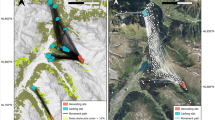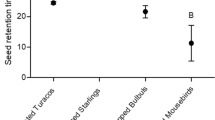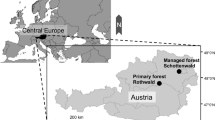Abstract
Scatter-hoarding animals such as corvids play a crucial role in the dispersal of nut-producing tree species. This interaction is well known for some corvids, but remains elusive for other species such as the magpie (Pica pica), an abundant corvid in agroecosystems and open landscapes of the Palearctic region. In addition, the establishment of the individual dispersed seeds—a prerequisite for determining seed-dispersal effectiveness—has never before been documented for the interaction between corvids and nut-producing trees. We analyzed walnut dispersal by magpies in an agroecosystem in southern Spain. We used several complementary approaches, including video recording nut removal from feeders, measuring dispersal distance using radio tracking (with radio transmitters placed inside nuts), and monitoring the fate of dispersed nuts to the time of seedling emergence. Magpies were shown to be highly active nut dispersers. The dispersal distance averaged 39.6 ± 4.5 m and ranged from 4.1 to 158.5 m. Some 90% of the removed walnuts were cached later, and most of these (98%) were buried in the soil or hidden under plant material. By the time of seedling emergence, ca. 33% of nuts remained at the caching location. Finally, 12% of the cached nuts germinated and 4% yielded an emerged seedling, facilitating the transition to the next regeneration stage. The results demonstrate for the first time that magpies can be an effective scatter-hoarding disperser of a nut-producing tree species, suggesting that this bird species may play a key role in the regeneration and expansion of broadleaf forests in Eurasia.



Similar content being viewed by others
References
Andrén H (1990) Despotic distribution, unequal reproductive success, and population regulation in the jay Garrulus glandarius L. Ecology 71:1796–1803
Baddeley A, Turner R (2005) Spatstat: an R package for analyzing spatial point patterns. J Stat Softw 12:1–42
Birkhead TR (1991) The magpies: the ecology and behaviour of black-billed and yellow-billed magpies. T&AD Poyser, London
Bossema I (1979) Jays and oaks: an eco-ethological study of a symbiosis. Behaviour 70:1–116
Brodin A, Lundborg K (2003) Is hippocampal volume affected by specialization for food hoarding in birds? Proc R Soc Lond B 270:1555–1563
Buxó R (1997) Arqueología de las plantas. Crítica, Barcelona
Cain ML, Milligan BG, Strand AE (2000) Long-distance seed dispersal in plant populations. Am J Bot 87:1217–1227
Castro J, Hódar JA, Gómez JM (2006) Seed size. In: Basra A (ed) Handbook of seed science and technology. Haworth’s Food Products Press, New York, pp 397–427
Castro J, Puerta-Piñero C, Leverkus AB, Moreno-Rueda G, Sánchez-Miranda A (2012) Post-fire salvage logging alters a key plant–animal interaction for forest regeneration. Ecosphere 3:art90
Clarkson K, Eden SF, Sutherland WJ, Houston AI (1986) Density dependence and magpie food hoarding. J Anim Ecol 55:111–121
Cramp S, Perrins CM (1994) Handbook of the birds of Europe the Middle East and North Africa. The birds of the Western Palearctic. Volume VIII. Crows to finches. Oxford University Press, Oxford
Cristol W (2005) Walnut caching behavior of American crows. J Field Ornithol 76:27–32
Darley-Hill S, Johnson WC (1981) Acorn dispersal by the blue jay (Cyanocitta cristata). Oecologia 50:231–232
Feenders G, Smulders TV (2011) Magpies can use local cues to retrieve their food caches. Anim Cognit 14:235–243
Grinnell J (1936) Up-hill planters. Condor 38:80–82
Gómez JM (2003) Spatial patterns in long-distance dispersal of Quercus ilex acorns by jays in a heterogeneous landscape. Ecography 26:573–584
Gómez JM (2004) Importance of microhabitat and acorn burial on Quercus ilex early recruitment: non-additive effects on multiple demographic processes. Plant Ecol 172:287–297
Healy SD, Krebs JR (1992) Food storing and the hippocampus in corvids: amount and volume correlated. Proc R Soc Lond B 248:241–245
Henty CJ (1975) Feeding and food-hiding responses of jackdaws and magpies. Br Birds 68:463–466
Homet-Gutiérrez P, Schupp EW, Gómez JM (2015) Naturalization of almond trees (Prunus dulcis) in semi-arid regions of the Western Mediterranean. J Arid Environ 113:108–113
Hougner C, Colding J, Söderqvist T (2006) Economic valuation of a seed dispersal service in the Stockholm National Urban Park, Sweden. Ecol Econ 59:364–374
Johnson WC, Adkisson CS, Crow TR, Dixon MD (1997) Nut caching by blue jays (Cyanocitta cristata L.): implications for tree demography. Am Midl Nat 138:357–370
Johnson WC, Webb T III (1989) The role of blue jays (Cyanocitta cristata L.) in the post-glacial dispersal of fagaceous trees in eastern North America. J Biogeogr 16:561–571
Källander H (2007) Food hoarding and use of stored food by rooks Corvus frugilegus. Bird Study 54:192–198
Lenda M, SKórka P, Knops JMH, Morón D, Tworek S, Woyciechowski M (2012) Plant establishment and invasions: an increase in a seed disperser combined with land abandonment causes an invasion of the non-native walnut in Europe. Proc R Soc Lond B 279:1491–1497
Leverkus AB, Rey-Benayas JM, Castro J (2016) Shifting demographic conflicts across recruitment cohorts in a dynamic post-disturbance landscape. Ecology 97:2628–2639
Martí R, Del Moral JC (eds) (2003) Atlas de las aves reproductoras de España. Dirección General de Conservación de la Naturaleza-Sociedad Española de Ornitología, Madrid
Martínez JG (2011) Urraca–Pica pica. In: Salvador A, Morales MB (eds) Enciclopedia virtual de los vertebrados españoles. Museo Nacional de Ciencias Naturales, Madrid. http://www.vertebradosibericos.org (version 16-09-2011)
Morán-López T, Alonso CL, Díaz M (2015) Landscape effects on jay foraging behavior decrease acorn dispersal services in dehesas. Acta Oecol 69:52–64
Mosandl R, Kleinert A (1998) Development of oaks (Quercus petraea (Matt.) Liebl.) emerged from bird-dispersed seeds under old-growth pine (Pinus sylvestris L.) stands. For Ecol Manage 106:35–44
Pesendorfer MB, Sillett TS, Koeing WD, Morrison SA (2016) Scatter-hoarding corvids as seed dispersers for oaks and pines: a review of a widely distributed mutualism and its utility to habitat restoration. Condor 118:215–237
Pinheiro J, Bates D, DebRoy S, Sarkar D, R Core Team (2016). nlme: Linear and Nonlinear Mixed Effects Models. R package version 3.1-128
Pons J, Pausas JG (2007) Acorn dispersal estimated by radio-tracking. Oecologia 153:903–911
Pons J, Pausas JG (2008) Modelling jay (Garrulus glandarius) abundance and distribution for oak regeneration assessment in Mediterranean landscapes. For Ecol Manag 256:578–584
Puerta-Piñero C, Brotons L, Coll L, González-Olabarría JR (2012) Valuing acorn dispersal and resprouting capacity ecological functions to ensure Mediterranean forest resilience after fire. Eur J For Res 131:835–844
R Core Team (2014) R: a language and environment for statistical computing. R Foundation for Statistical Computing, Vienna. http://www.R-project.org/
Richards TJ (1958) Concealment and recovery of food by birds, with some relevant observations on squirrels. Br Birds 51:497–508
Schupp EW, Fuentes M (1995) Spatial patterns of seed dispersal and the unification of plant population ecology. Ecoscience 2:267–275
Schupp EW, Jordano P, Gómez JM (2010) Seed dispersal effectiveness revisited: a conceptual review. New Phytol 188:333–353
Tamura N, Hayashi F (2008) Geographic variation in walnut seed size correlates with hoarding behaviour of two rodent species. Ecol Res 23:607–614
Thanos CA (1994) Aristotle and Theophrastus on plant–animal interactions. In: Arianoutsou M, Groves R (eds) Plant–animal interactions in Mediterranean-type ecosystems. Kluwer, Dordrecht, pp 3–11
Vander Wall SB (1990) Food hoarding in animals. Chicago Press, Chicago
Vander Wall SB (2001) The evolutionary ecology of nut dispersal. Bot Rev 67:74–117
Waite RK (1985) Food caching and recovery by farmland corvids. Bird Study 32:45–49
Zinkivskay A, Nazir F, Smulders TV (2009) What–where–when memory in magpies (Pica pica). Anim Cognit 12:119–125
Acknowledgements
This study was supported by the projects CGL2014-53308-P of the Spanish Government and Remedinal 3 (S2013/MAE-2719) of the Madrid Government. The Consejería de Medio Ambiente (Junta de Andalucía) provided fieldwork permission. LMB was supported by a FPI scholarship (BES-2015-075276) from the Spanish Government. AL acknowledges support from the University of Granada and Project GEI Spain (CGL2014-52838-C2-1-R) funded by the Spanish Ministerio de Economía y Competitividad, including European Union ERDF funds. We thank Dr. E.W. Schupp and two anonymous reviewers for providing suggestions that enhanced the manuscript.
Author information
Authors and Affiliations
Contributions
JC, LPC, PVS, SR, and JMRB conceived and designed the experiments. JC, MMM, AL, and LMB performed the field work. JC, MMM, and AL performed statistical analyses. JC wrote the first draft of the manuscript; all authors provided editorial advice.
Corresponding author
Additional information
Communicated by Carlos L. Ballare.
Electronic supplementary material
Below is the link to the electronic supplementary material.
442_2017_3848_MOESM1_ESM.pdf
Figure S1. Characteristics of the feeders used in this study. The first feeder (feeder 1 in Fig. 1 of the manuscript) consisted of an almost flat roof of a chicken house placed 2.20 m above the ground plus a wooden slat that prevented the nuts from rolling down (upper picture). The second feeder (feeder 2 in Fig. 1 of the manuscript) was a 30 × 40 cm wooden cage with a metal bottom, held 1.7 m from the ground by a metal post and located below the canopy of a walnut tree (bottom picture). We knew from previous observations that magpies foraged or perched regularly in both locations. The two feeders were placed 100 m from each other. Figure S2. Details of radio transmitter insertion into a walnut. The nut was split open with a knife, a portion of the kernel similar in weight to the transmitter was removed, the transmitter was inserted into the nut with the antenna rolled, and finally the two halves of the shell were glued together with superglue (Loctite®). (PDF 886 kb)
442_2017_3848_MOESM2_ESM.doc
Video recording with a movement-sensitive camera in feeder 1 on 27 October 2015, showing three magpies at once, with two of them retrieving a nut each (containing transmitters in this case). The time that appears in the video is the local time, one hour ahead of solar time (thus, it was 8 am solar time). It can be observed that the second magpie that removed a nut flew westwards beyond a group of trees, where it was lost at a distance of ca. 130 m from the feeder. This transmitter was not found despite a thorough search at distances of up to 300 m, and may represent a long-distance dispersal event. (DOC 152722 kb)
Rights and permissions
About this article
Cite this article
Castro, J., Molina-Morales, M., Leverkus, A.B. et al. Effective nut dispersal by magpies (Pica pica L.) in a Mediterranean agroecosystem. Oecologia 184, 183–192 (2017). https://doi.org/10.1007/s00442-017-3848-x
Received:
Accepted:
Published:
Issue Date:
DOI: https://doi.org/10.1007/s00442-017-3848-x




